ESC's 10 rules for treating acute & chronic heart failure
M3 India Newsdesk Feb 01, 2022
Here is a quick rundown of the 10 rules by The European Society of Cardiology (ESC) on diagnosing, managing and treating acute and chronic heart failure.
The updated recommendations for the diagnosis and management of acute and chronic heart failure (HF) includes ten key points:
- An angiotensin-converting enzyme inhibitor or angiotensin receptor-neprilysin inhibitor, a beta-blocker, a mineralocorticoid receptor antagonist, and a sodium-glucose cotransporter 2 inhibitor are recommended as cornerstone therapies for all patients with HF with reduced ejection fraction and may be considered in patients with mildly reduced ejection fraction.
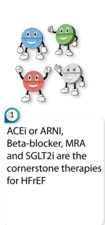
- In patients with left ventricular ejection fraction (LVEF) ≤35%, in sinus rhythm, cardiac resynchronisation therapy is recommended when there is a left bundle branch block (LBBB) and QRS duration >150 ms. It should be considered in cases of LBBB and QRS duration between 130 and 149 ms, or non-LBBB and QRS duration >150 ms, and may be considered in patients with non-LBBB and QRS duration of 130-149 ms.
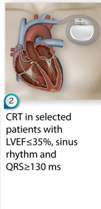
- In patients with a left ventricular ejection fraction of less than 35%, an implanted cardioverter-defibrillator is suggested in situations of ischaemic origin and should be evaluated in cases of non-ischaemic aetiology.
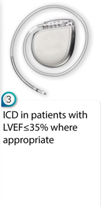
- Heart transplantation is advised in selected patients with advanced HF who are unresponsive to medication treatment, and mechanical circulatory support should be explored.
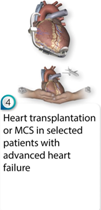
- Treatment of acute HF consists of addressing specific causes (i.e. acute coronary syndrome, hypertension emergency, arrhythmia, mechanical cause, pulmonary embolism, infection, and tamponade) as well as diuretics, vasodilators, inotropes, vasopressors, short-term mechanical support, and renal replacement therapy. The indications and timing of these therapies vary according to the clinical presentation (i.e. acute decompensated heart failure, acute pulmonary oedema, isolated right ventricular failure, and cardiogenic shock) and severity of the condition.
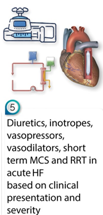
- A pre-discharge visit and an early follow-up visit within 1-2 weeks of release from an HF hospitalisation are advised to evaluate symptoms of congestion, medication tolerance, and to initiate and/or increase the dose of evidence-based therapy.
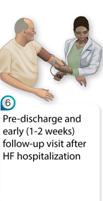
- It is advised that patients with HF be evaluated for anaemia and iron insufficiency on a periodic basis. Intravenous iron supplementation with ferric carboxymaltose should be considered if the serum ferritin level is 100 ng/mL or if the serum ferritin level is 100-299 ng/mL with transferrin saturation of 20% in symptomatic patients with LVEF 45% to improve symptoms and quality of life. In patients recently hospitalised for HF with LVEF 50% to reduce the risk of HF re-hospitalisation.
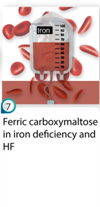
- When atrial fibrillation is linked with increasing HF symptoms, pulmonary vein ablation should be explored for rhythm control.

- Patients with congestive HF and secondary mitral regurgitation should be assessed by a heart team. They should be considered for percutaneous edge-to-edge mitral valve repair if they meet the criteria for improved outcomes.

- Patients with 'red flags' for cardiac amyloidoses, such as HF at 65 years of age and an increased left ventricular wall thickness, should be tested. Tafamidis is suggested for individuals with New York Heart Association class I or II symptoms with transthyretin-cardiac amyloidosis in order to alleviate symptoms, cardiovascular hospitalisation, and death.
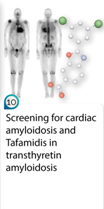
Click here to see references
Disclaimer- The views and opinions expressed in this article are those of the author's and do not necessarily reflect the official policy or position of M3 India.
The author is a practising super specialist from New Delhi.
Only Doctors with an M3 India account can read this article. Sign up for free or login with your existing account.
4 reasons why Doctors love M3 India
-
Exclusive Write-ups & Webinars by KOLs
-
Daily Quiz by specialty
-
Paid Market Research Surveys
-
Case discussions, News & Journals' summaries
